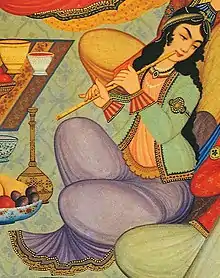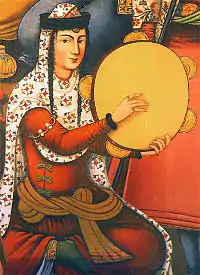Setar
A setar (Persian: سهتار, pronounced [seˈt̪ʰɒːɾ]), also spelled and romanized as setaar or setâr, is an Iranian musical instrument. It is a member of the lute family. It is played with the index finger of the right hand. The range of the setar spans more than two and a half octaves.
 A typical Iranian setar | |
| String instrument | |
|---|---|
| Classification | Plucked |
| Hornbostel–Sachs classification | 321.321 |
| Playing range | |
 | |
| Related instruments | |
| Tambouras, Tar, Tanbur | |
At some point in the 18th century, musicians added a fourth string, which most of the time is tuned to the same pitch as the bass string.
The setar has 25–28 moveable frets. Frets are usually made of animal intestines ("gut"), although in the past strings were made of silk. Some modern commercial models feature frets made of nylon.
The setar originated in Persia before the spread of Islam,[1] and is related to the tanbur. However, in recent centuries, the setar has evolved into something more closely resembling the tar, both in tuning and playing style.
Etymology
The Persian word سهتار setâr is a combination of سه se—meaning "three"—and تار târ—meaning "string", therefore the word gives the meaning of "three-stringed" or "tri-stringed".
Uyghur variant
The Satar (Uighur: ساتار; Chinese: 萨塔尔, Sàtǎ'ěr)[lower-alpha 1] is an important instrument in 12 muqam. It is a bowed lute with 13 strings, one raised bowing string and 12 sympathetic strings, tuned to the mode of the muqam or piece being played.
History
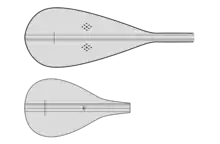
The setar belongs to the tanbur family, but today it is very close to the tar in terms of playing method, shape of the handle and techniques. In the past, the instrument had three strings. The modern setar has four strings, the third and fourth strings forming a course, played at the same time. The combination of the two is usually referred to as the "bam" (بم), the same name as one of the strings.
The need for the additional fourth string was recognized centuries ago, by intellectual thinkers such as Abu Nasr al-Farabi, Abu Ali Sina, Safi al-Din Ermavi, and (in the 20th century) the late Abul Hassan Khan Saba.
The new wire is the "fourth wire" because it is the last of the four strings to be added to the instrument. However, it was inserted between the second and third string, so that when looking at the modern instrument being played, it is the third string from the bottom.
The newest string is known as the Mushtaq (مشتاق) string and according to a narration of Abolhassan Saba, was first used by a dervish named Mushtaq Ali Shah.
The setar was first recorded for His Master's Voice in the winter of 1888-1889 (1306 AH) by Arthur James Twain. He recorded singer Batool Rezaei (stage name: Banoo Machol Parvaneh, mother of Khatereh Parvaneh) playing setar, accompanied by Habibollah Samaei on santur, Ghavam Al-Sultan on tar and Agha Mehdi Navai on ney.[2][3]
Tuning the setar
The open strings on the setar are tuned in scientific pitch notation to C3 C4 • G3 • C4. The lowest pitch strings played together as a course (C3 C4 are the bass string (made of bronze or phosphor-bronze) and the drone (made of steel). The highest pitch strings are the "yellow" G3, made of bronze or phosphor-bronze and the "white" G3 made of steel.
Players not only tune the strings of the setar, but also move the gut or nylon bridges that are tied around the neck, between the neck and the strings. Since these frets are moveable, players can move them to set notes closer or farther apart. The instrument is designed to play microtones, pitches between the standard western pitches on the piano keyboard. A Koron lowers and a Sori raises the pitches by quarter steps (flats and sharps are half-steps).
The table below contains the names and playable samples of notes, for a string set to C. It can be used to set the frets by players tuning their instruments.
| Fret number below nut | Name of note when open sting is C | Sound clip of note |
|---|---|---|
| 0 | C4 | |
| 1 | D4 koron | |
| 2 | D4 | |
| 3 | E4 flat | |
| 4 | E4 koron | |
| 5 | E4 | |
| 6 | F4 | |
| 7 | F4 sori | |
| 8 | F4 sharp | |
| 9 | G4 | |
| 10 | A4 flat | |
| 11 | A4 koron | |
| 12 | A4 | |
| 13 | B4 flat | |
| 14 | B4 koron | |
| 15 | B4 | |
| 16 | C5 | |
| 17 | D5 koron | |
| 18 | D5 | |
| 19 | E5 flat | |
| 20 | E5 koron | |
| 21 | E5 | |
| 22 | F5 | |
| 23 | F5 sharp | |
| 24 | G5 | |
| 25 | A5 flat |
Notable setarists
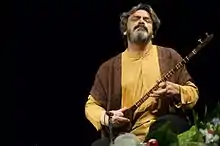
- Hossein Alizadeh
- Mohammad-Reza Lotfi
- Atâ Jangouk
- Kayhan Kalhor
- Mirza Abdollah
- Sa'id Hormozi
- Yusef Forutan
- Ahmad Ebadi
- Abolhasan Saba
- Dariush Safvat
- Mojtaba Mirzadeh
- Jalal Zolfonun
- Dariush Talai
- Massoud Shaari
- Behdad Babaei
- Hafez Nazeri
- Abdollah Alijani Ardeshir
- Mehdi Aminian
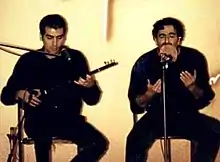
See also
Notes
- The Chinese translation—萨塔尔, sàtǎ'ěr—is a transliteration of the original Persian loanword (via Uyghur).
References
| Wikimedia Commons has media related to Setar. |
- The Stringed Instrument Database
- Mohammad Reza Sharaili. "اولین نوای ضبط شده از سه تار (Translation: The first recorded sound from Setar)". womenofmusic.ir. Archived from the original on 31 August 2018.
- "از دوره پهلوی اول، زنان وارد عرصه اجتماعی هنر شدند/ پروانه؛ نوازنده اولین سه تار ضبط شده در تاریخ موسیقی ایران (Translation: From the first Pahlavi period, women entered the social arena of art / Parvaneh; Musician of the first recorded setar in the history of Iranian music)". mehrkhane.com. Archived from the original on 21 April 2015.
......بتول رضایی...پروانه؛ نوازنده اولین سه تار ضبط شده در تاریخ موسیقی ایران... وی افزود: بتول رضایی با اسم مستعار پروانه، اولین نوازنده زن است که صدای سازش ضبط شده است. اولین اثری که از ساز سه تار ضبط شده است، صدای سه تار او است. او نوازنده توانمندی بود که در سال 1312، در سن 25 سالگی به دلیل بیماری سل فوت کرد. او نوازنده اولین سه تار ضبط شده در تاریخ موسیقی ایران است. (translation: Batool Rezaei. The Butterfly; Musician of the first recorded setar in the history of Iranian music. He added: Batool Rezaei, nicknamed Parvaneh, is the first female musician whose compromise voice has been recorded. The first work recorded from a setar instrument is her setar sound. She was a talented musician who died of tuberculosis in 1913 at the age of 25. She is the musician of the first recorded setar in the history of Iranian music)
.jpg.webp)
